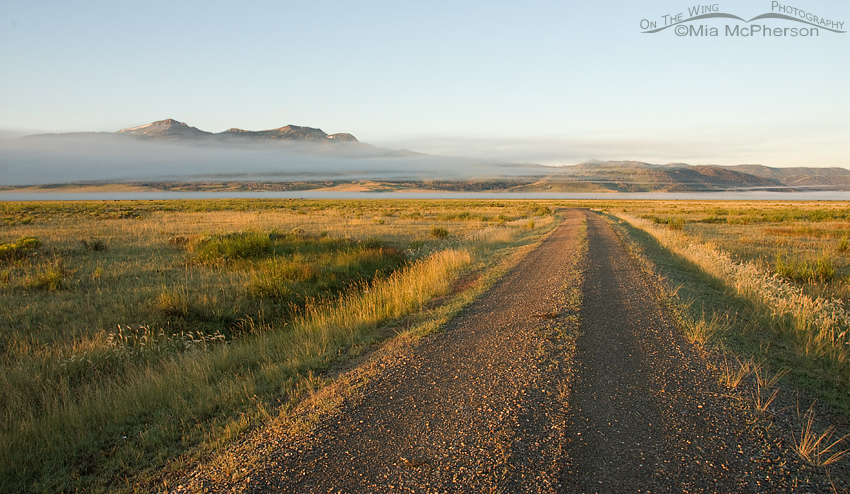 Early morning fog and golden light at Red Rock Lakes National Wildlife Refuge, Montana (lower lake campground) – Nikon D200, handheld, f11, 1/45, ISO 400, +1.0 EV, Nikkor 18-200mm VR at 18 mm, natural light
Early morning fog and golden light at Red Rock Lakes National Wildlife Refuge, Montana (lower lake campground) – Nikon D200, handheld, f11, 1/45, ISO 400, +1.0 EV, Nikkor 18-200mm VR at 18 mm, natural light
Life is an adventure. I can’t deny that, ever. There are times when there are bumps in the road, smooth sailing, or a multitude of mishaps that occur in a single journey. Having a sense of humor truly helps.
I spent last week in Montana, or maybe it was two, it sure felt like two.
The first destination was Red Rock Lakes National Wildlife Refuge a place I’ve become very familiar with and a location that I think is incredibly beautiful. Coming into the refuge from I-15 to the west requires an almost 30 mile drive from Monida (named for being on the state lines of Montana and Idaho) on a rough gravel road that has sweeping views of the Centennial Mountains and the wide Centennial Valley below them.
I thoroughly enjoy seeing the healthy grasslands, sagebrush, lush marshes, wetlands, forests, lakes and streams along the way and because of the old ranches, old barns in various stages of collapse, weather worn corrals and fences I always feel that I have stepped back in time. I can only imagine what the valley looked like when huge herds of Bison grazed in the grasses before the first European settlers arrived. I can easily visualize it as being wild, windswept, thriving with natural wonders and achingly pristine.
The roads were fairly rough in June and July in areas where creeks had overflowed their banks and washed away some portions of the road and deep gashes where tires had dug in. Summer is short in the Centennial Valley and much road repair work needs to be done in just a few weeks.
On the way east towards the refuge we came across a man named Buck who had pulled his SUV over to the side of the gravel road. He looked flushed and we soon saw that he had a horribly flat tire, shredded in fact. The lug nuts were on too tight for Buck to get them off and he asked if we had a cheater bar, which we did. Once the tire was removed and the spare put on we had a nice chat with Buck, a real likable fellow originally from Montana but now living in Georgia. I was glad to see Buck on his way to meet his wife and family and hoped that he wouldn’t have anymore tire problems along the way, the closest tire repair shop was about 30 miles from where we stood.
I’ll write more about flat tires in a bit, trust me.
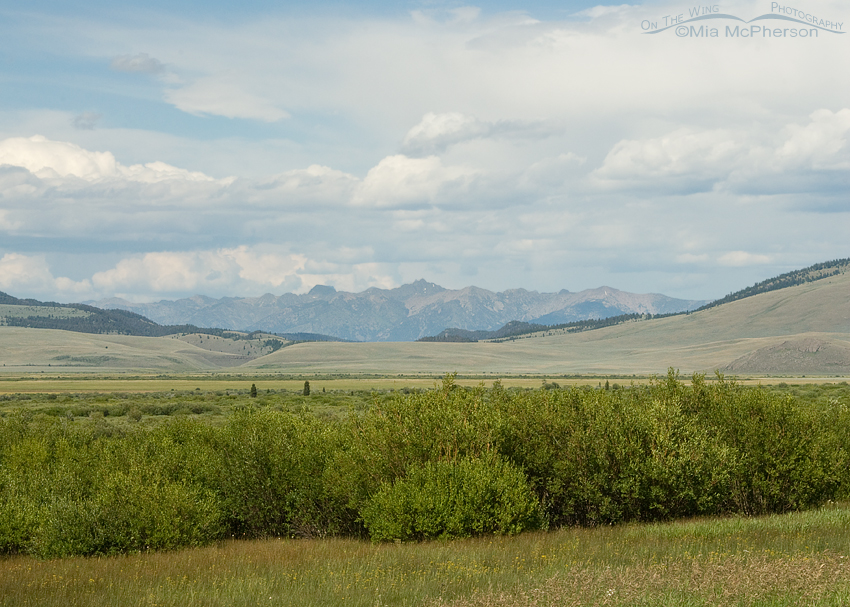 Summer view of an eastern part of Red Rock Lakes National Wildlife Refuge – D200, handheld, f20, 1/180, ISO 400, +0.3 EV, Nikkor 18-200mm VR at 70mm, natural light
Summer view of an eastern part of Red Rock Lakes National Wildlife Refuge – D200, handheld, f20, 1/180, ISO 400, +0.3 EV, Nikkor 18-200mm VR at 70mm, natural light
When I visited Red Rock Lakes NWR this past June and July the distant mountains in this image were covered in snow, their icy peaks reminders of how untamed and challenging winter can be in the Centennial Valley. There are year round residents in the valley and for months at a time the only way to get out is with snowmobiles or Snowcats. I admire those tough people, I know I would get a bad case of cabin fever or at the very least severe bird photography withdrawals.
When I left Red Rock Lakes NWR in July the lower lake campground was surrounded by a weather worn fence and although it was man made I loved photographing Savannah Sparrows on the beautiful, old wood. From campsite #6 there was a lovely, unobstructed view of the lower lake, it was an absolutely gorgeous scene. Great to have that first cup of coffee while watching Trumpeter Swans floating gracefully by in a lake mist or shorebirds and ducks flying over the water. I expected to see the same scenery last week. I was wrong. I expected to see the Short-eared Owls flying over the grasses and sagebrush during the day, I was wrong about that too.
 View from campsite #6 at the lower lake – Nikon D200, handheld, f6.3, 1/1250, ISO 400, +0.3 EV, Nikkor 18-200mm VR at 18mm, natural light
View from campsite #6 at the lower lake – Nikon D200, handheld, f6.3, 1/1250, ISO 400, +0.3 EV, Nikkor 18-200mm VR at 18mm, natural light
Why was the view different? Every three to four years the refuge allows some of the ranchers cattle grazing rights on the refuge. The idea is that through conservation grazing is to maintain and increase the biodiversity of the natural grasslands. I’m not so sure about that but to be fair hundreds; if not thousands, of Bison used to graze in the Centennial Valley which probably did maintain and increase the biodiversity found at that time which might not be much different than the cattle grazing there last week. Conservation grazing at refuges is a controversial topic, just do a Google search on it. Some refuges are forced to allow conservation grazing but more than a few have stopped that practice altogether.
There were hundreds of yearling cows grazing on the grasses of the Lower Lake part of the refuge, these yearling cows were a bit destructive. Signs had been knocked down then resurrected with huge piles of rocks around the posts to keep the teen-aged cows from knocking them down again. The beautiful old fence that surrounded three sides of the campground showed obvious damage, some of the weather worn timbers were on the ground while others were braced with new portions of fencing. There was also an electric fence around the campground that had not been there before. And the previously open view of the lake is now obstructed by a new fence & cattle gate.
The Red Rock Lakes NWR does make a tiny amount of money from allowing the cattle to graze and in today’s recession that might help the refuge a bit. The cuts in federal money has hit all of our National Refuges hard. We were told at the refuge headquarters that the cattle would be out of the refuge within a week or so. I could go on and on about those cows but for now I will just continue the story.
Short-eared Owls nest and roost on the ground and it appeared that with all of the cattle grazing that the Short-eared Owls were staying away from the area. That was a disappointment to me, I love seeing them flying over the grasses, hunting voles or perching on the low sagebrushes or half hidden by the grasses. There were; however, many other birds present, some of them are already making their fall migration to the south.
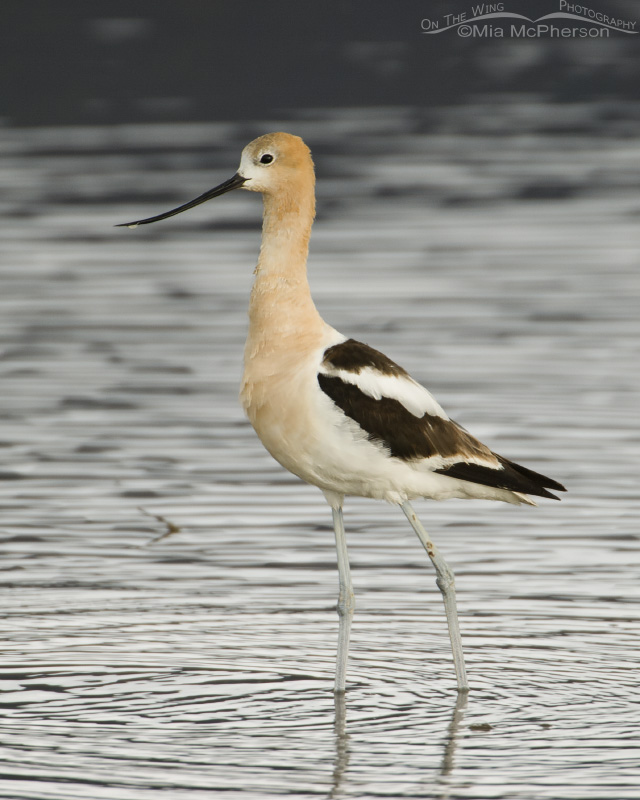 American Avocet in low light – Nikon D200, f5.6, 1/80, ISO 400, +1.3 EV, Nikkor 200-400mm VR with 1.4x TC at 400mm, natural light
American Avocet in low light – Nikon D200, f5.6, 1/80, ISO 400, +1.3 EV, Nikkor 200-400mm VR with 1.4x TC at 400mm, natural light
Lighting conditions at Red Rock Lakes NWR can vary dramatically from morning to afternoon or even minute to minute as storms move through the valley. It can create the most beautiful or dramatic light or the challenges of shooting in low light with very slow shutter speeds. As I have mentioned before, I enjoy the challenge of creating images in less than optimal conditions.
There were a variety of shorebirds present near the dam on the west side of the Lower Lake. There were Wilson’s Phalaropes in their nonbreeding plumage, a few Marbled Godwits, Black-necked Stilts, Least Sandpipers, Long-billed Dowitchers, Killdeer, Western Sandpipers and American Avocets.
Even when conditions are bad for photography we would head out in the morning and afternoon to photograph the birds that we found. When I photographed the Avocet above clouds had moved in over the dam and the sunlight was occasionally peeking through the dark clouds and the effect that created was that the water looked black and white. I like how the Avocet’s colors in the photo above stands out so well from the water. I deleted more of the images I took that evening than I normally do because with such low shutter speeds I had a lot of blurry or less than sharp files.
The second morning while heading out of the lower lake area of the refuge to head east towards the upper lake area we met a very interesting fellow from Vancouver, British Columbia, Rod Wellington. His goals and aspirations are amazing and inspiring. Rod was at Red Rock Lakes to scout out the source of the Missouri River in preparation for a rafting/kayaking trip from the source, down the Missouri to the end of the Mississippi River on the coast of the Gulf of Mexico. What is more is that he intends to do the same with the seven longest rivers on seven different continents all of which will be done on self-propelled crafts!
I meet the most interesting people through and because of my photography.
On the second evening we were back at the dam trying to get images in similar light then headed back to the campsite when it began threatening to rain and evening darkness approached. I jumped out of the pickup at the new “bungee” cord gate (to keep those teen-aged cattle out) and heard a very loud hissing noise.
Hmm. Flat tire #1. A rock or piece of gravel had punctured the tire. Racing against the darkness, gusting wind and rain all that can be done is the spare tire dropped down from the under carriage of the pickups body, changing the tire would have to wait until daybreak. Then there are nearly 30 miles to travel on the rough gravel road heading towards Monida plus another 15 on the interstate to Lima to get the flat fixed by Al at Big Sky Sports & Service, he has a really cute dog named Corey, if I am remembering correctly.
At the lower lake campground I do have a cell signal but right after leaving the refuge my cell signal drops out until I-15 at Monida, that is a LONG way to go thinking “If we have a flat now we are stuck because we don’t have a spare or a way to call AAA for help!”.
After getting the flat tire on the pickup we decide its time to leave Red Rocks and head to Cut Bank in Glacier County, Montana stopping in Lima to get the flat fixed before heading north on I-15.
All was good, or was it?
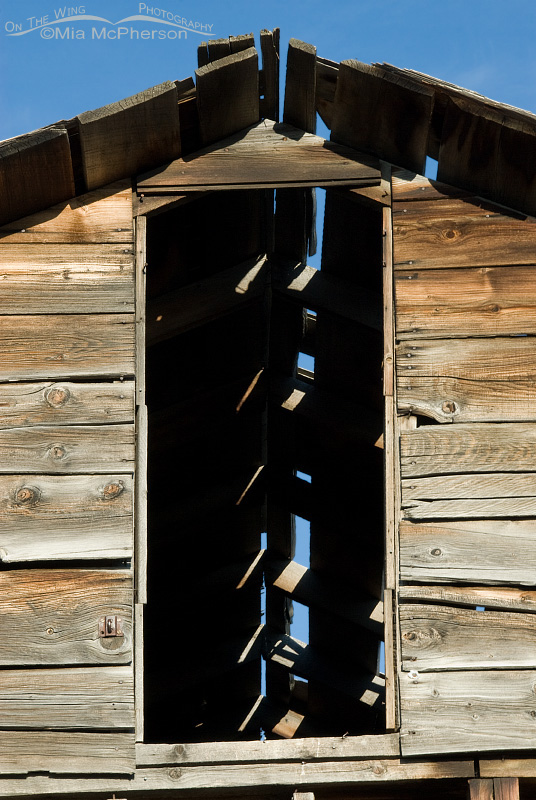 Old Granary Window, Cut Bank, Glacier County, Montana – Nikon D200, f16, handheld, 1/80, ISO 320, -1.3 EV, Nikkor 18-200mm VR at 105mm, natural light
Old Granary Window, Cut Bank, Glacier County, Montana – Nikon D200, f16, handheld, 1/80, ISO 320, -1.3 EV, Nikkor 18-200mm VR at 105mm, natural light
I love the farm and the people in Cut Bank. The farm reminds me of my childhood because of the rusty old vehicles parked around in pastures, Model A’s, ancient tractors and pick up trucks. The granaries leaning from the strong winds Montana has, the wood aged from the elements and time. Wide open fields, silos, horse barns and barbed wire fences. The people are great too, friendly, welcoming, informative and very down to earth. Some of my earliest memories are about farms. It feels like an adopted “home” to me.
After arriving at the farm in the evening and meeting more great people from Canada; Bev, Donna, Steve and Paul who are on a long trip too, I was exhausted after dinner so I went to the camper to sleep. Just after waking up the next morning Ron told me some news, we had another flat tire. This time it was on the camper. A nail. Murphy’s Law? Or bad Karma?
While Ron went off to town to get the camper’s flat tire fixed and the pickup’s spare changed with the tire previously repaired in Lima I stayed at the farm trying to catch up on three days of work that had come in. Oh joy. I would have rather have gone into town and walked around at my taller than normal height (I always feel taller in Montana) and savored the small town atmosphere. I also wanted to stop at Diana & Jerry’s place to see the newborn Alpaca that was born the day before.
When Ron got back from town he came in practically bursting with the news that when he drove back down the lane to the farm he saw something surprising. A Short-eared Owl sitting on a fence post and what was so unusual was that Short-eared Owls hadn’t been seen on the farm before! How awesome, I looked forward to photographing the owl.
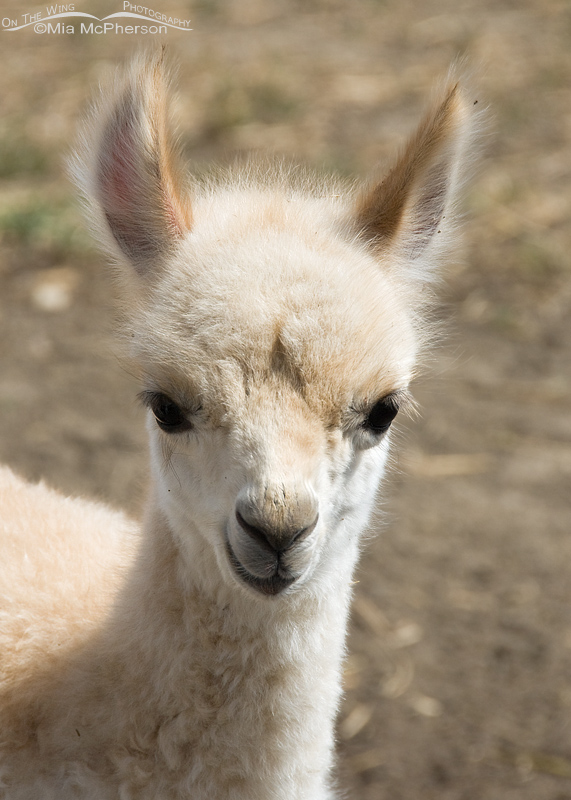 A very young Alpaca – Nikon D200, handheld, f9, 1/640, ISO 250, -0.3 EV, Nikkor 18-200mm VR at 200mm, natural light
A very young Alpaca – Nikon D200, handheld, f9, 1/640, ISO 250, -0.3 EV, Nikkor 18-200mm VR at 200mm, natural light
Normally I don’t photograph captive animals but I could not resist photographing the cute baby Alpaca. It was still a bit wobbly on it’s long legs and had such big, dark eyes. It was also a great deal of fun to watch it kick up it’s heels and run around in amongst the sheep and adult Alpacas. Diana spins the soft wool of these lovely South American creatures when she isn’t out farming hundreds of acres of barley and lentils. I really admire her and how spunky she is.
Flat tires out of the way? Check! Work under control? Check! Camera batteries charged? CF cards formatted? Check!
Time to head a bit further north to Glacier National Park! I’ve been there before in the month of June but never late enough in the season to go up the Going-to-the-Sun-Road and I was very excited to finally see it.
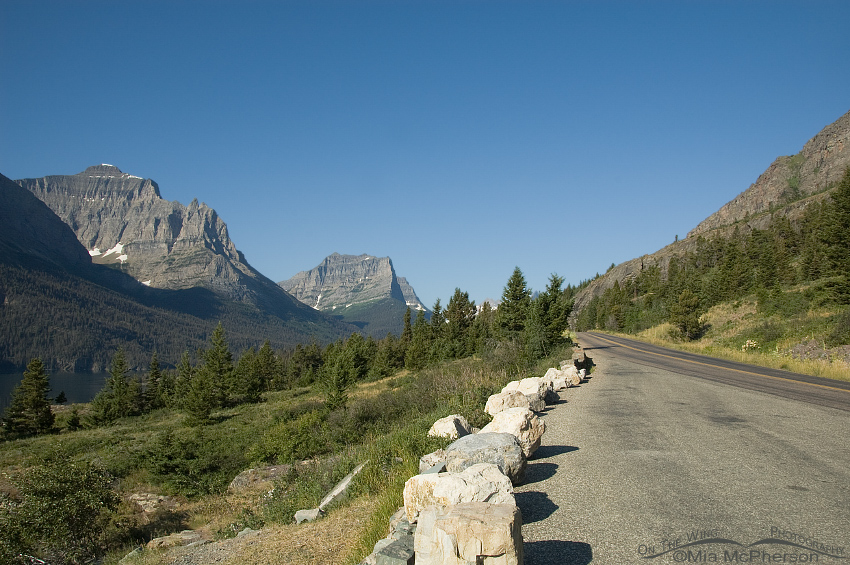 A view from the road, Glacier National Park, Glacier County, Montana – Nikon D70, handheld, f10, 1/400, ISO 320, Nikkor 18-200mm VR at 18mm, natural light
A view from the road, Glacier National Park, Glacier County, Montana – Nikon D70, handheld, f10, 1/400, ISO 320, Nikkor 18-200mm VR at 18mm, natural light
The views at Glacier National Park are breath taking so along the way I had to stop and take some photos. I can’t resist and who knows when I’ll be back there again. The air was crisp and smelled wonderful. It was early and there weren’t a lot of cars heading up from the east. Yet.
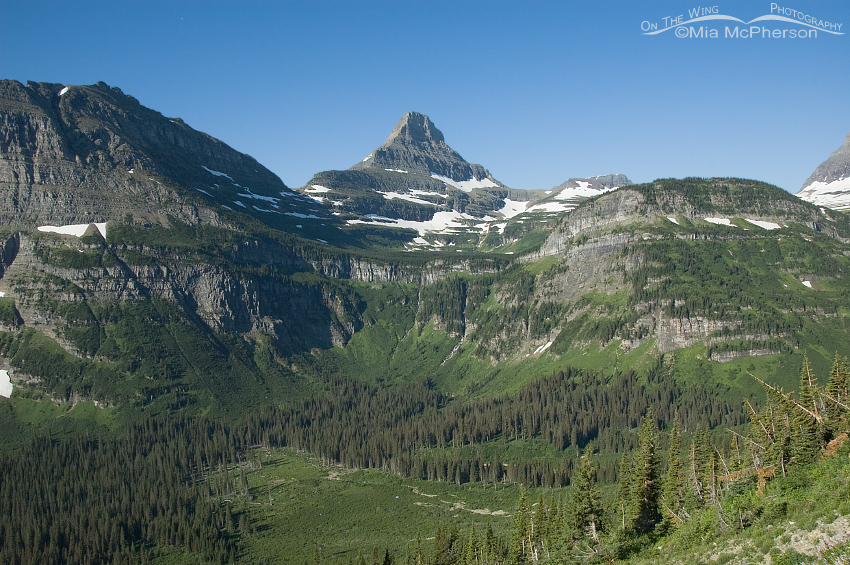 Looking down into a valley in Glacier National Park, Glacier County, Montana – Nikon D70, handheld, f10, 1/400, -0.3 EV, Nikkor 18-200mm VR at 18mm, natural light
Looking down into a valley in Glacier National Park, Glacier County, Montana – Nikon D70, handheld, f10, 1/400, -0.3 EV, Nikkor 18-200mm VR at 18mm, natural light
I’ve been blessed to travel a lot in my life and I have found that every place has it’s own unique beauty. I think the State and National Parks and the National Wildlife Refuges are without a doubt my favorites in the United States. I know I am biased towards that opinion because I’m a bird and nature photographer. When I look down into a valley like this one I find myself wondering about all of the creatures that live there and up higher I think about the sheep and goats. My mind wanders while I am behind the lens.
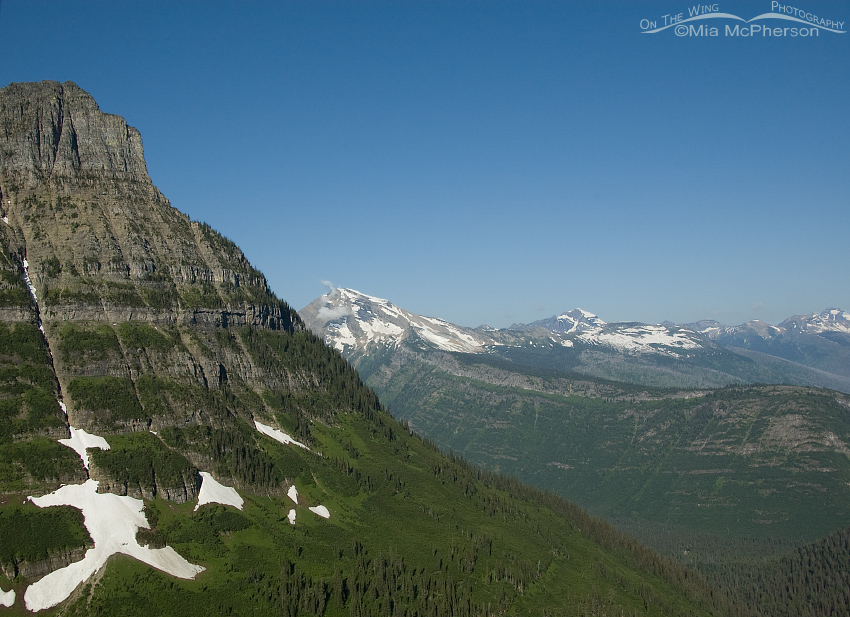 Summit of Going-to-the-Sun-Road Glacier National Park – Nikon D70, handheld, f10, 1/640, ISO 320, -0.3 EV, Nikkor 18-200mm VR at 22mm, natural light
Summit of Going-to-the-Sun-Road Glacier National Park – Nikon D70, handheld, f10, 1/640, ISO 320, -0.3 EV, Nikkor 18-200mm VR at 22mm, natural light
The view from the summit of Going-to-the-Sun-Road is even more spectacular than I had imagined or what had been described to me. There was construction going on at the top where traffic was down to one lane. Some people might have grumbled about being stopped there for 10-15 minutes, but I was thrilled because it gave me time to really look around and photograph. The greens up that high seemed rich and saturated and the sky a wonderful blue. I was able to glance around and ID some of the wildflowers and used my long lens to peer into the valley below hoping to catch sight of a Moose or a Grizzly Bear. The air felt delicious on my skin. Yeah, I didn’t mind the wait at all.
I relished it.
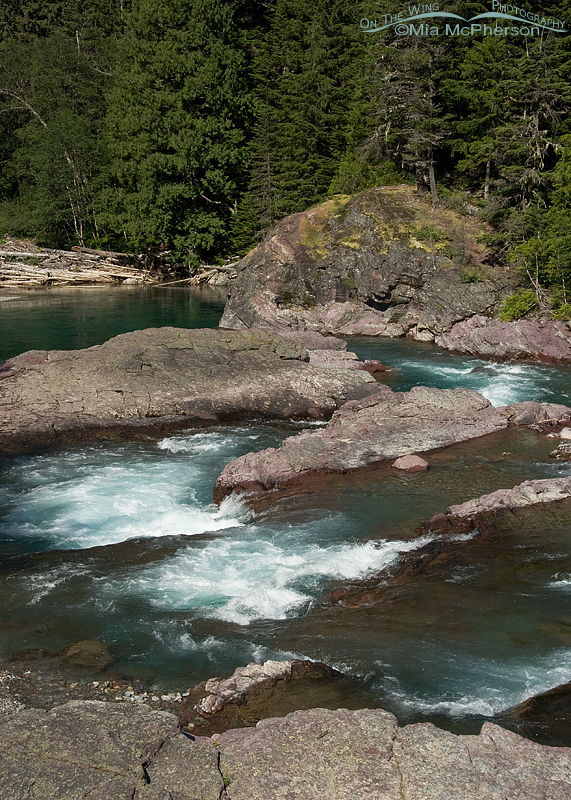 Rushing Water, Glacier National Park – Nikon D200, handheld, f8, 1/640, ISO 320, Nikkor 18-200mm VR at 46mm, natural light
Rushing Water, Glacier National Park – Nikon D200, handheld, f8, 1/640, ISO 320, Nikkor 18-200mm VR at 46mm, natural light
On the way down from the summit heading towards West Glacier I did take some images of Bird Woman Falls but unfortunately at that time of the day it was still in the shadows and my resulting images were far too noisy for my tastes. As a female Bird Photographer though I got a kick out of taking photos of a feature called Bird Woman Falls. It seemed fitting to me.
I’m a little nervous about emailing the picture above to my mother, whenever I send her photos of water where there might be trout or other fish she always asks me why I don’t stop and go fishing. She’s been a fisherwoman since she was a young child. My answer is always the same, “Mom, I’d rather be photographing than fishing”.
The sound of rushing water is mesmerizing to me though and I thoroughly enjoyed hearing this water tumbling over and through the rocks. A very natural and stimulating symphony.
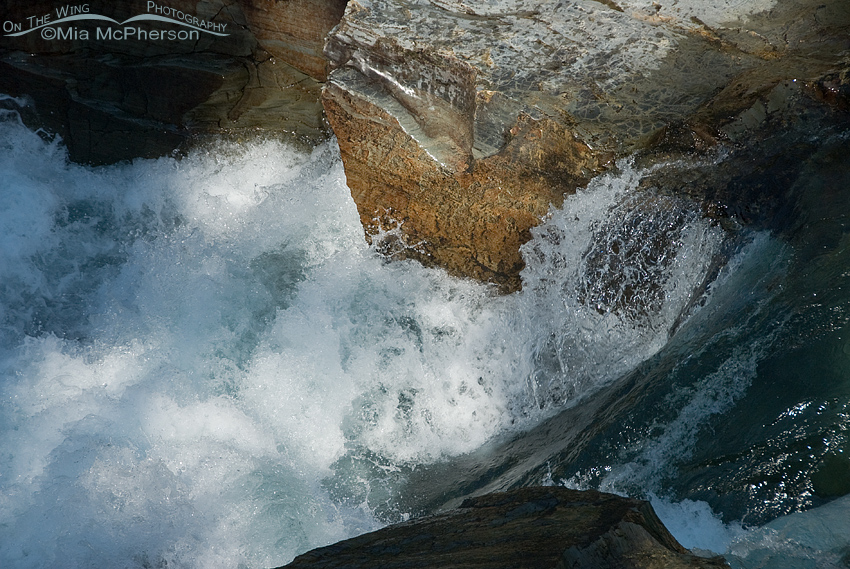 Rapids close up, Glacier National Park – Nikon D200, handheld, f8, 1/640, ISO 320, -0.7 EV, Nikkor 18-200mm VR at 120mm, natural light
Rapids close up, Glacier National Park – Nikon D200, handheld, f8, 1/640, ISO 320, -0.7 EV, Nikkor 18-200mm VR at 120mm, natural light
I also could not resist zooming in on the rapids and waterfalls, I wanted to try to capture the raw power and energy I saw and felt when viewing them. The water looked pure, cold and magnificently wild.
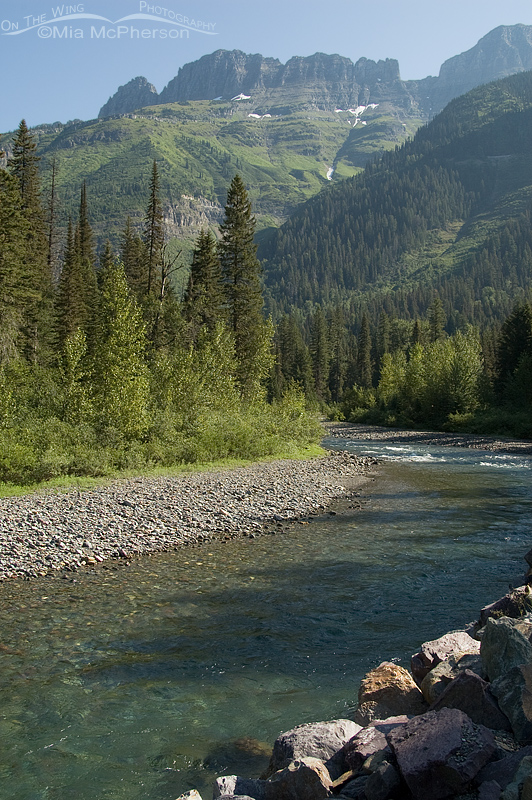 Beautiful River view in Glacier National Park – Nikon D70, handheld, f10, 1/200, ISO 320, Nikkor 18-200mm VR at 24mm, natural light
Beautiful River view in Glacier National Park – Nikon D70, handheld, f10, 1/200, ISO 320, Nikkor 18-200mm VR at 24mm, natural light
There are times (many times) when I get so wrapped up in what I am seeing and photographing that later I can not remember what creek, river, mountain or valley I have photographed. This was another one of those times where the beauty I saw and felt overrode the desire to write down the names of the features I photographed. That’s okay with me though, I can see every mile in my mind’s eye and in my photographs.
I didn’t see or photograph any bears, moose, sheep or birds on my journey through the park but I am fine with that, perhaps another time.
Heading back to Cut Bank was enjoyable too. We stopped at a little place called Snow Slip Inn for lunch, a fine feast of homemade french fries and Angus burgers that were very tasty and filling. The Inn was rustic, small and homey and a perfect place to dine after visiting Glacier National Park.
But there was hope for even more excitement that evening because the thoughts of getting photos of the Short-eared Owl were beckoning to me. I kept my fingers crossed that the owl would be there along the lane to the farm and that the light would be gorgeous in the evening.
 A surprise Short-eared Owl – Nikon D200, f6.3, 1/1500, ISO 400, Nikkor 200-400mm VR with 1.4x TC at 400mm, natural light, not baited
A surprise Short-eared Owl – Nikon D200, f6.3, 1/1500, ISO 400, Nikkor 200-400mm VR with 1.4x TC at 400mm, natural light, not baited
Later that afternoon I was not disappointed, the Short-eared Owl was perched on a fence post down the lane but the first time we spotted it the sun was fairly high. Then on a return trip later that evening to photograph the owl the light was very good and only got better towards sunset. The bird was very cooperative that session, we photographed it for over an hour and 40 minutes. It would preen, yawn, stretch and doze while we photographed it on that fence post. It seemed very comfortable with our presence.
 Short-eared Owl preening, now those are sharp talons! – Nikon D200, f6.3, 1/1250, ISO 320, +0.3 EV, Nikkor 200-400mm VR with 1.4x TC at 335mm, natural light, not baited
Short-eared Owl preening, now those are sharp talons! – Nikon D200, f6.3, 1/1250, ISO 320, +0.3 EV, Nikkor 200-400mm VR with 1.4x TC at 335mm, natural light, not baited
I mentioned in my post yesterday that the owl was sitting on a fence post near CRP (Conservation Reserve Program) land and I feel it provided excellent backgrounds for these images. Farmers are paid to allow the fields to go back to their natural state, there are conditions of course, they can not farm it again for an extended period of time and they must fence it but those acres (this section was rather large) provide a holding capacity for the animals and birds who live there so they are able to thrive even surrounded by cultivated farmland.
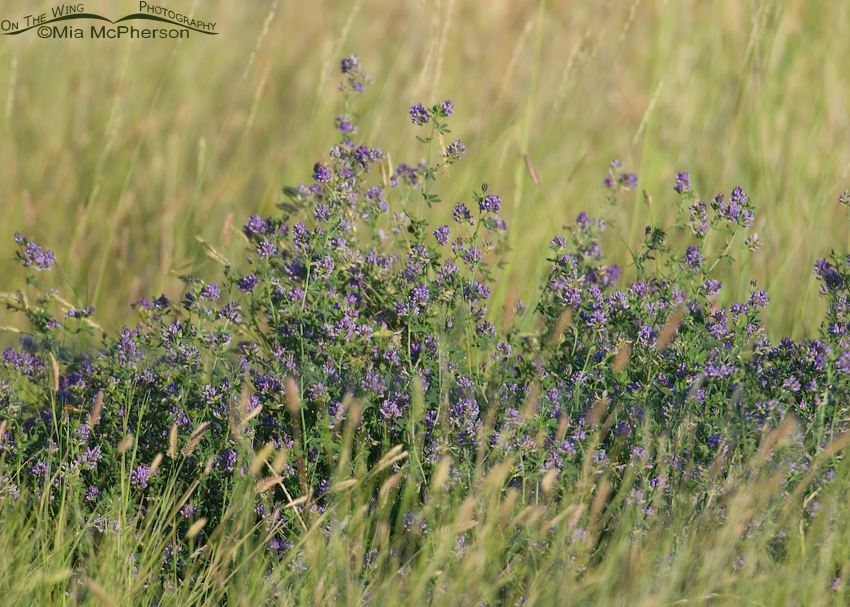 Alfalfa Blues – Nikon D200, f6.3, 1/640, ISO 320, Nikkor 200-400mm VR with 1.4x TC at 400mm, natural light
Alfalfa Blues – Nikon D200, f6.3, 1/640, ISO 320, Nikkor 200-400mm VR with 1.4x TC at 400mm, natural light
In the CRP land there are native wildflowers growing amongst the grasses, I’m not sure if the Alfalfa above is native or if some seeds were blown or deposited by a bird or rodent onto the CRP land but it sure was beautiful in the background of some of my images. There were also mounds of Yellow Sweet Clover plants growing in the grasses too.
 Dozing Short-eared Owl – Nikon D200, f6.3, 1/320, ISO 400, +0.7 EV, Nikkor 200-400mm VR with 1.4x TC at 335mm, natural light, not baited
Dozing Short-eared Owl – Nikon D200, f6.3, 1/320, ISO 400, +0.7 EV, Nikkor 200-400mm VR with 1.4x TC at 335mm, natural light, not baited
I mentioned earlier that this Short-eared Owl dozed while we photographed it, that might have been a bit of an understatement as it seemed the owl dozed often and had trouble keeping it’s eyes open. I know that in bird and wildlife photography it is preferable to photograph them with their eyes open and with some form of eye contact but I wanted to photograph this owl with it’s eyes closed, it is after all just another normal behavior and I enjoy showing birds doing all kinds of things. Besides that I think this owl looks pretty darned cute with it’s eyes closed.
 Staring Short-eared Owl – Nikon D200, f6.3, 1/320, ISO 400, +0.7 EV, Nikkor 200-400mm VR with 1.4x TC at 400mm, natural light, not baited
Staring Short-eared Owl – Nikon D200, f6.3, 1/320, ISO 400, +0.7 EV, Nikkor 200-400mm VR with 1.4x TC at 400mm, natural light, not baited
As the sun began to set the owl seemed a little more active and started to preen again and stared right at me. What gorgeous eyes these owls have.
As the light faltered I hated to leave the owl but it seemed as if on cue when we turned to leave the owl lifted off and flew out over the land, I suppose to go and find something to eat.
The next morning we were leaving Cut Bank and heading south the Red Rock Lakes NWR again on the way home, we looked for the owl but it wasn’t seen. I was very happy to have seen this one period!
I don’t have any pictures to add after this point but the story still goes on.
It is a long drive from northern Montana to Red Rock Lakes NWR, we didn’t arrive at the entrance to the lower lake refuge area until late afternoon. On the way to the campground there are four rather large concrete lined dips in the road that have been filled with water since the first time I visited this year in June. Water seeps through the grasslands and flows through these dips as the water flows towards the lower lake, it has washed away some of the gravel on the edge of the concrete which makes travel in that area a bit rough. I’ll have to stand in the pickup bed to see if I can get images of what the dips look like from a higher perspective than the road.
I’ve mentioned that the road to the refuge is gravel and that it can be rough in places.
Well, just as we started to go into the first dip past the entrance to the lower lake campground a low tire pressure sensor went off. AGAIN! Not bothering to slow down we got to the campground in what would be record time for us because normally we are looking for birds to photograph. The camper was backed in to the campsite and it only took one try. The tire continued to leak air. In an amazingly short period of time the camper was set up, chocks in place, leveled and secure, the spare was put on the pickup and the flat tire loaded onto the pick up bed. Wow, I guess we were getting faster because we had been having SO much practice with these flats.
Oh oh though, the next day was Sunday, the tire repair shop would be closed in Lima. We didn’t have Al’s business card with the phone number to the shop so I used my phone and Google to locate it. It was getting close to 4:30 pm by that time, the shop closed at 5 pm according to the sign. No time to drive 45 miles and get the flat fixed that night anyway. Ron spoke to Al, the shop owner and he agreed to meet us the next morning at his shop even though it was his day off at 7 am. We told him that if we weren’t there promptly at 7 am that we probably had another flat on the way out!
When I paid the camping fee for the night I put a short note inside the envelope along with the cash in which I wrote that we really loved Red Rock Lakes NWR.. that we MUST because we were there and had already had 3 flat tires. I got a kick out of writing that note and hope that whoever read it had a few chuckles.
We did drive around a little that night looking for birds to photograph with some apprehension. I had drank about a half a bottle of an Evolution Amber Ale, I’m a light weight and don’t drink much so I had a sweet little buzz going on when we came across those darn teen-aged cattle in the road again. Just fit to be tied at that point I rolled down my window and talked to the cow closest to the pickup and told it that “I’m going to have my revenge tonight, I am having a HAMBURGER for dinner!” Almost as soon as I said “hamburger” that cow jumped a little, turned and bolted away from the road. It was absolutely hilarious.
We woke very early the next morning and broke camp, got the camper hitched to the pickup and at o’dark hundred we were pulling out of the campground driving towards the entrance when three, possibly four Short-eared Owls flew up from the grasses along side of the road and flew in front of us for a bit in the glow from the headlights.
Go figure, the owls we hoped to see at Red Rock Lakes NWR and there was NO light.
After a 30 mile, nerve wracking ride on that gravel road we made it to I-15 without any tire problems. Twenty minutes later we pulled into Al’s tire repair shop where he fixed that last flat.
Or was it?
After thanking Al for getting up so early on his day off we got back on I-15 and drove south towards Salt Lake City. We breathed a sigh of relief we had made it out that gravel road from the refuge without another flat on the way home.
Or did we?
Technically I suppose you could say we made it home without another flat but when putting the camper into the driveway… guess what?
Another one of the camper tires had apparently been damaged and had a slow leak and by the next morning it too was completely flat.
I hope we have used up our flat tire allocation for the year.
What a journey. Yes, it certainly does pay to have a sense of humor!
After writing all of this I feel exhausted, I think I’ll retire
Life is good.
Mia
Click here to see more of my Short-eared Owl photos plus facts and information about this species.


WOW…what a trip for you! I was so emerged in your story that every couple paragraphs I was starting to get anxious cause I knew ANOTHER FLAT TIRE was on the horizon!!! ha ha
I loved your story; made me feel like I was right there! I love all your pictures and reading about your equipment as well…my first camera was a D70; then a D200 and now a D700. What I have learned is that it is about the passion of the person behind the viewfinder…amping up the gear is not the answer and you are proof of that. I would MUCH rather view your art than alot of stuff I see on G+ with the 800’s etc.
Thank you for sharing you love of photography and wildlife with us. Looking forward to MORE stories WITHOUT the flats!!! ha ha
Linda, I’m happy to say there were NO flat tires this last trip to Montana!
I agree with you, amping up gear is not the answer if you don’t get to know how to use the one you have completely. It isn’t always about the gear but the skill of the photographer behind it.
Thank you for your wonderful comment, it has me smiling.
I’ve come back to view these images and read your narrative a few times since you first posted this. Never having been to Montana myself (yet), I can still enjoy the scenery through your beautiful images. You are a very good story-teller as well!
Julie,
Montana is beautiful and it is easy to fall in love with it. Big skies, mountains, grasslands, wildlife galore and wide open spaces. Lakes, rivers and streams. I’m nearly as addicted to Montana as I am to bird photography! Getting closer to your visit to Utah, bet you are excited!
The first image heading into RRL NWR is my kind of road, nice to see wide open country with green grass. The view from Going-to-the-sun road in Glacier NP is just stunning. Wonderful story and pictures. I enjoyed reading about the entire adventure, except now I an wanting to go on a road trip and have some evolution amber ale.
Jim,
I’d love to share an Evolution Amber Ale if you head up here! Aren’t road trips great?
Wow!! What an epic trip, I sure hope that WAS your flat tire allotment for a long time! As ever, your photos are wonderful – I absolutely love the Avocet, and the dozy owl. I’ve been to the Going-to-the-sun Road, sixteen years ago, in July, and the whole place was still covered in snow! Really enjoyed this post!
Hi Nicole!
I really love the avocet image too because it looks like the water is in black & white and that the avocet is in color. No PS trickery there, just the way it was!
Seeing images of the snow removal on Going-to-the-Sun-road is amazing, how they get through such deep snow is beyond me.